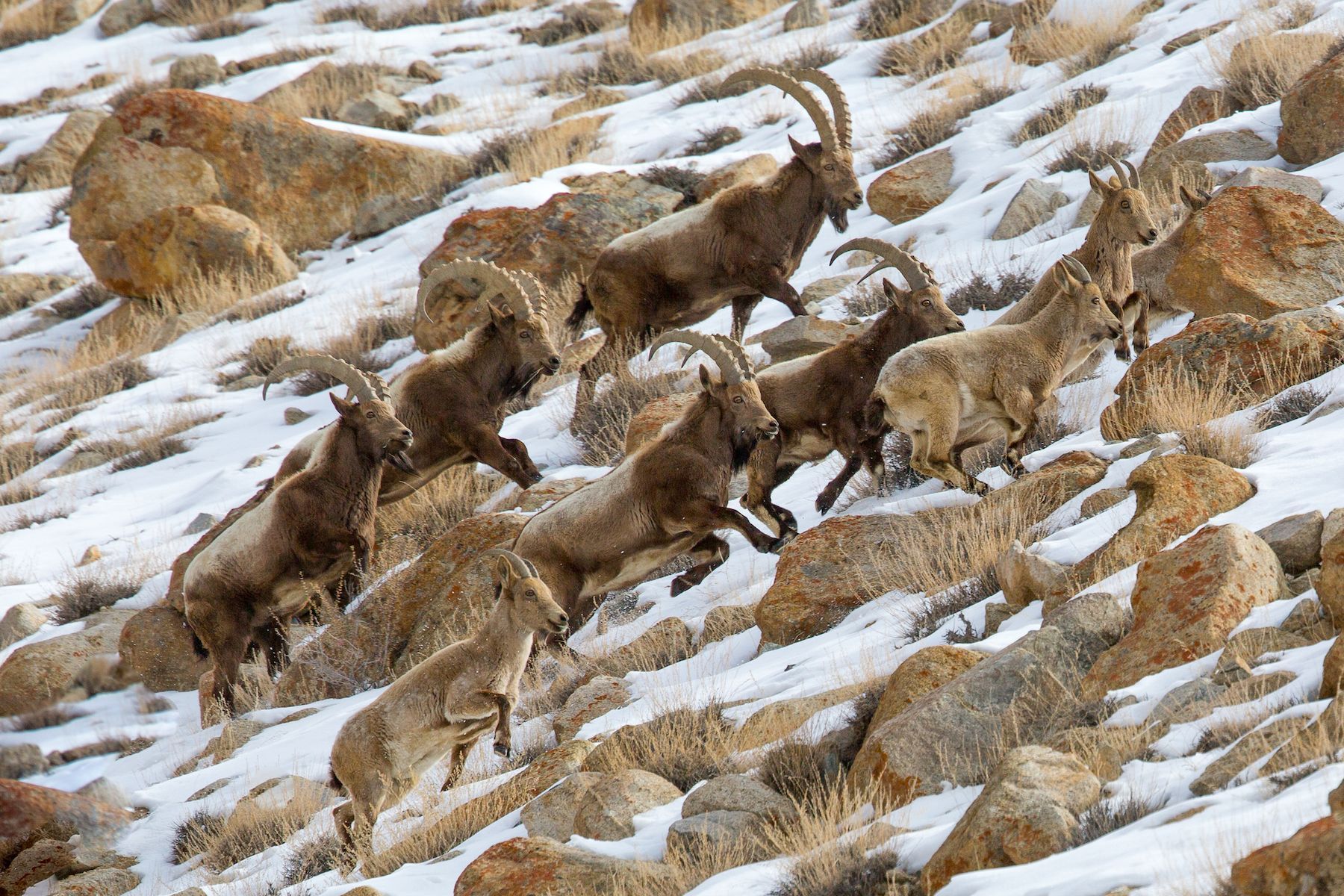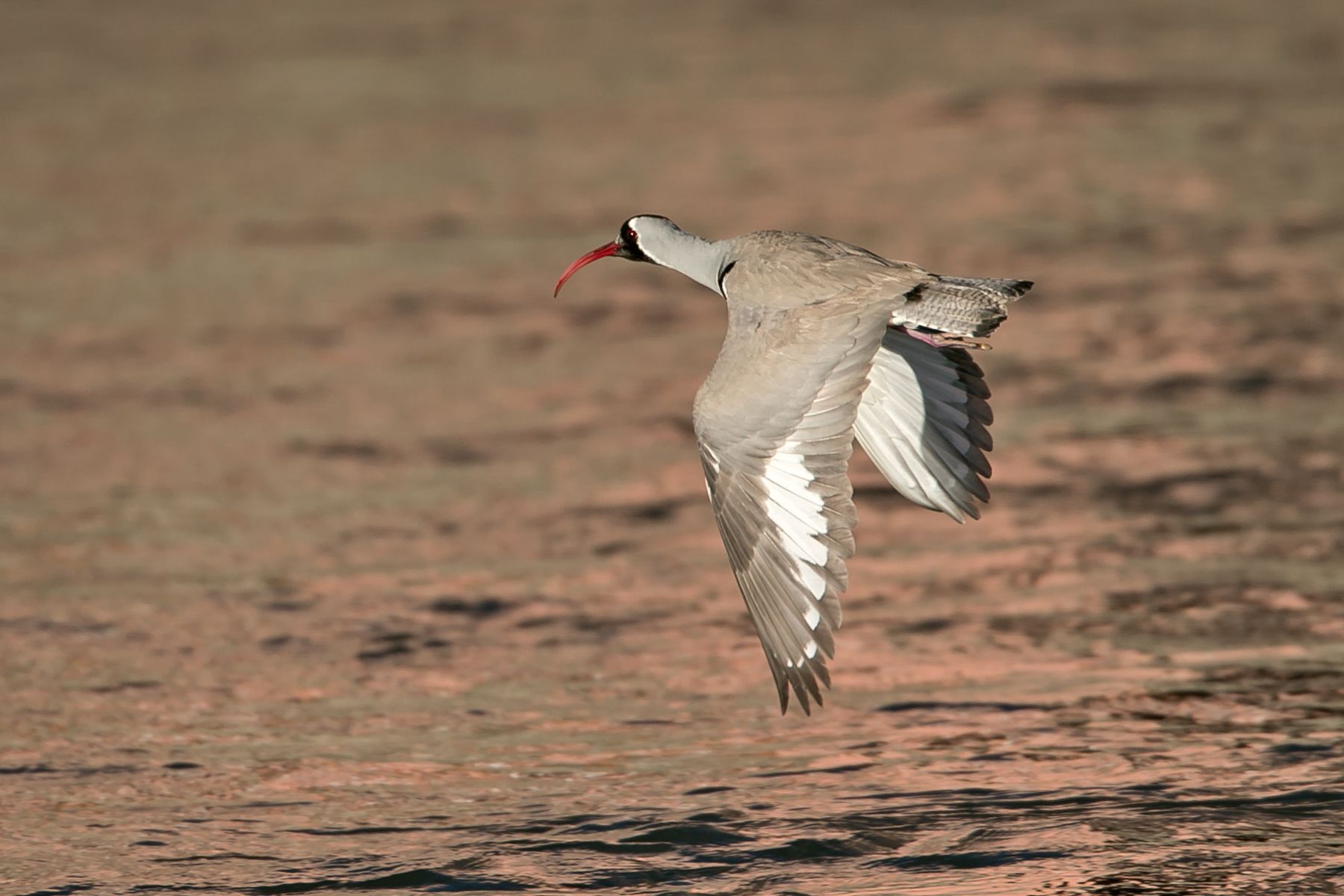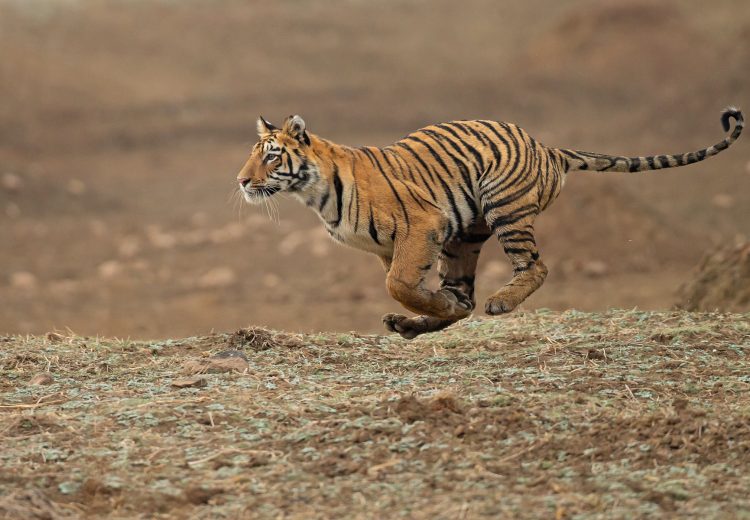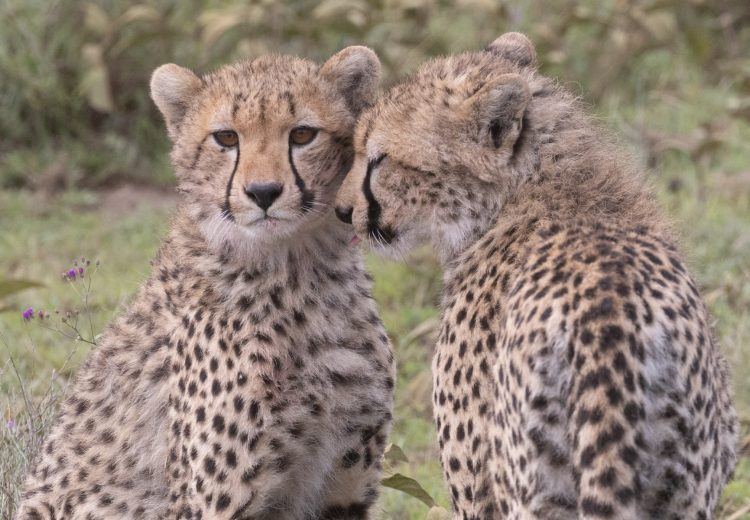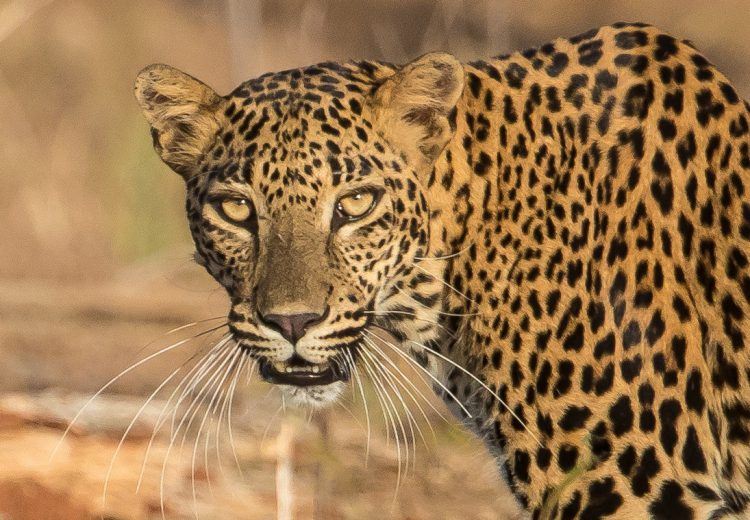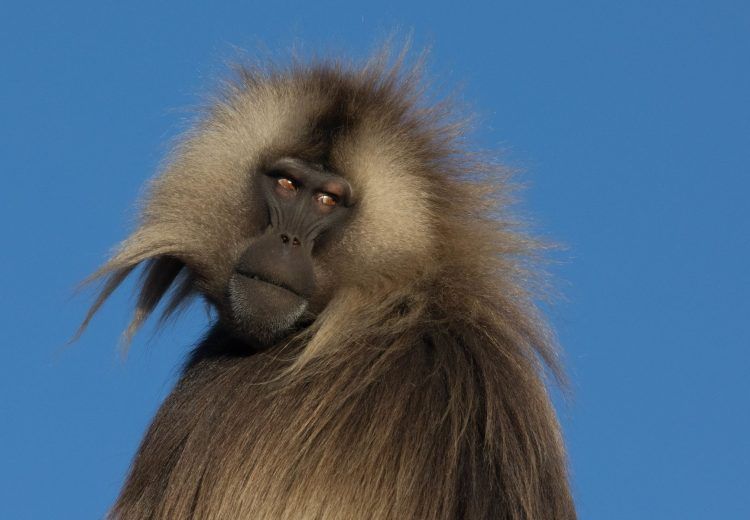India
SNOW LEOPARDS & WILDLIFE OF LADAKH, INDIA – In Search of the Grey Ghost of the Mountains



































































































Ancient Buddhist monasteries, like the one at Thikse, dominate the Indus valley (Image by Mark Beaman)

The villagers debate its fate. The village doctor, the owner of the sheep wants it killed, other villagers tell him the Snow Leopard is 'the glory of our mountains' and insist it is handed over to the Wildlife Department for release elsewhere (Image by Mark Beaman)

The understandably frightened Snow Leopard peers out from the back of the pen (image by Mark Beaman)

Mating is not always a peaceful affair (Image by Mark Beaman)

Ancient petroglyphs are often to be seen (image by Mark Beaman)

The landscapes of eastern Ladakh, part of the Tibetan Plateau, are so different. This is Tso Moriri lake (Image by Mark Beaman)

Ladakh is the place to see and photography the shy, fabled Snow Leopard (Image by Mike Watson)

The eyes of Buddha (Image by Mark Beaman)

Sometimes it gets completely out of hand! (Image by Mark Beaman)

Morning prayers (puja) can even be fun (Image by Mark Beaman)

The pretty little Blanford's Snowfinch nests in pika burrows (Image by Mark Beaman)

The male ibexes often feed in groups (Image by Mark Beaman)

The debate won by the 'save the Snow Leopard' contingent, the villagers coax it into a net, surprisingly gently, and it is taken away by the Wildlife Department for release (Image by Mark Beaman)

The Snow Leopard looks frustrated, as well it might be (Image by Mark Beaman)

Tso Kar lake with a wolf pit in the foreground. Local people bait the pit, from which the wolves cannot escape (Image by Mark Beaman)

A Tibetan Sandgrouse calls to alert its nearby fellows (Image by Mark Beaman)

And finally, a story of hope for the Snow Leopard, at least in Ladakh. Here a Snow Leopard has been trapped in a sheep pen by villagers after killing four sheep (Image by Mark Beaman)

The horns of the male Urial are very striking (Image by Mark Beaman)

A Grey Wolf watches its territory from a hillside (Image by Mark Beaman)

The Solitary Snipe lives up to its name, inhabiting mountain streams (Image by Mark Beaman)

An ibex skull in a mountain valley (Image by Inger Vandyke)

Dominating the scene is the great peak of Stok Kangri (6,123m or 20,090ft) (Image by Mark Beaman

Tso Kar holds an impressive population of Argali, another wild sheep (Image by Mark Beaman)

'Fairy Pillars' form when a boulder protects the loose conglomerate underneath from erosion (Image by Mark Beaman)

Only to be stopped by some wire fencing (Image by Mark Beaman)

Pilgrims, like this woman spinning a prayer wheel as she goes, come to Thikse from far and wide (Image by Mark Beaman)

If you are lucky enough to coincide with a festival, the traditional costumes are wonderful to behold

Himalayan Snowcocks like the rocky ridges (Image by Mark Beaman)

and begins its stealthy descent (Image by Mark Beaman)

The Blue Sheep race to safety (Image by Mark Beaman)

The wild mountainscapes of Tso Kar (Image by Mark Beaman)

Kiang against the blue-grey mountains (Image by Mark Beaman)

A herd of Siberian Ibex run up a mountainside in Ladakh (Image by Inger Vandyke)

The main prey of the Snow Leopard in Hemis is the impressive Blue Sheep (Image by Mark Beaman)

It crouches and lies in wait, the sheep are oblivious of the danger (can you see its face in the upper right of the image?) (Image by Mark Beaman)

Upland Buzzards are common, hunting for pikas over the plains and slopes (Image by Mark Beaman)

A male Siberian Ibex is an impressive sight (Image by Mike Watson)

Woolly Hares are a favourite prey item for wolves (Image by Mark Beaman)

Along the Indus river one can find the lovely Ibisbill (Image by Mike Watson)

The mountain scenery elsewhere in Ladakh is equally impressive, and different (Image by Mark Beaman)

Even at Leh the mountains are never far away (Image by Mark Beaman)

A Kiang foal races ahead of its mother in eastern Ladakh (Image by Mark Beaman)

Often to be seen on the tops of the ridges (Image by Mark Beaman)

Sometimes the females come very close (Image by Mark Beaman)

A beautiful Wallcreeper forages on a cliff (Image by Mark Beaman)

The last rays of the sun strike the mountains of the Tibetan Plateau (Image by Mark Beaman)

Late winter and early spring is the mating season for Snow Leopards (Image by Mark Beaman)

It leaps... (Image by Mark Beaman)

The Indus River flows quietly through the willow and buckthorn groves (Image by Mark Beaman)

The last rays of the sun catch the Victory Monastery high above Leh (Image by Mark Beaman)

Snow Leopards blend in surprisingly well with the landscape. No wonder they can hide so well from other wildlife (Image by Mike Watson)

Thiksey Monastery at dawn, Ladakh

Before flying off to safety (Image by Mark Beaman)

Early in the morning the novice monks of Thikse blow their traditional horns (Image by Mark Beaman)

Our campsite is dwarfed by the mountains (Image by Mark Beaman)

The handsome Black-necked Crane still breeds in the marshes of Tso Kar (Image by Mark Beaman)

A small village nestles below starkly eroded mountainsides (Image by Mark Beaman)

But flight is never far from their minds in Snow Leopard country (Image by Mark Beaman)

The strange Groundpecker or Ground Tit, an aberrant tit that lives far from any tree (Image by Mark Beaman)

While his daughter-in-law winds it into a ball (Image by Mark Beaman)

It is the same male that was fighting with the female in between mating, when the area around its right eye was scratched! (Image by Mark Beaman)

Most monasteries in Ladakh are in naturally fortified positions, like this one at Spituk (Image by Mark Beaman)

Once inside Hemis National Park we are surrounded by awesome mountains (Image by Mark Beaman)

Another prey species for the Snow Leopard is the Urial. Here we can see a male and a female on an arid slope (image by Mark Beaman)

Robin Accentors haunt brushy areas (Image by Mark Beaman)

But the Indus Valley scenery is gentle compared to the wild grandeur of Hemis National Park (Image by Mark Beaman)

While Alpine Choughs soar overhead (Image by Mark Beaman)

Leh is dominated by its ancient City Palace (Image by Mark Beaman)

As we watch for Snow Leopards we are just pinpricks in a vast landscape (Image by Mark Beaman)

A Ladakhi villager spins wool (Image by Mark Beaman)

A new kind of stock shelter like this one, with steel mesh roofing, are now keeping villagers' animals safe and helping transform attitudes to the Snow Leopard. Birdquest/Wild Images has donated the money for a shelter for one of the villages (Image by Mark Beaman)

A group of Kiangs (or Tibetan Wild Asses) run across the plains of Tso Kar, a great area for wildlife (Image by Mark Beaman)

Red Foxes are quite common in Ladakh. This one is in its thick winter coat (Image by Mark Beaman)

The sheep near and it leaps from cover (Image by Mark Beaman)

But is a fraction too late (Image by Inger Vandyke)

The delightful little Royle's Pika is hunted by foxes, weasels and birds of prey (Image by Mark Beaman)

A Blue Sheep makes its way through the snow (Image by Mike Watson)

Grandad with grandson. Ladakhi people are a delight to be with (image by Mark Beaman)

Before entering a wild, almost vegetationless gorge (I(mage by Mark Beaman)

After a few moments it bolts for freedom once more (Image by Mark Beaman)

And are remarkably agile, helped by their long, heavy tail which acts as a counterweight as they jump from rock to rock (Image by Mike Watson)

While the debate goes on the Snow Leopard escapes but is cornered in a ditch (Image by Mark Beaman)

A Snow Leopard spots some Blue Sheep down below (Image by Mark Beaman)

A misty peak (Image by Mark Beaman)isty peak

The wild mountain landscapes of Ulay (Image by Mark Beaman)

Grey Wolves watch from the nearby slopes (Image by Mark Beaman)

An Ibisbill in flight over the Indus River in Ladakh (Image by Mike Watson)

Hurtling down the slope regardless of the rocks (Image by Mark Beaman)

There are some nice birds to photograph like this Bearded Vulture (or Lammergeier) (Image by Mike Watson

The moon rises over the mountains and the Snow Leopards begin to call (Image by Mark Beaman)

Their wide, furry paws act like snowshoes (Image by Mike Watson)

A Bearded Vulture's coloration merges with the rocks behind (Image by Mark Beaman)

Chortens in the sunset at Shey Monastery, Ladakh (Image by Inger Vandyke)

Snow Leopards, like this one, watch from the high ridges, waiting for the sheep to make a mistake (Image by Mark Beaman)

Even Grey Woilf, of the Tibetan form, is still quite common in Ladakh (Image by Mark Beaman)

The views of the Himalayas during the flights into and out of Leh can be awesome (Image by Mark Beaman)

Sometimes the males lock their horns and fight (Image by Mark Beaman)
|
Saturday 1st March –
Sunday 16th March 2025 Leaders: János Oláh and expert local trackers and guides |
16 Days | Group Size Limit 8 (1 space) |
|
Monday 1st March –
Tuesday 16th March 2027 Leaders: Wild Images leader to be announced and expert local trackers and guides |
16 Days | Group Size Limit 8 |
SNOW LEOPARD PHOTOGRAPHY TOURS IN LADAKH, INDIA WITH WILD IMAGES
The bewitching Snow Leopard is one of the most evocative mammals of our planet and on this special Ladakh wildlife and Snow Leopard photography tour, we will make a big effort to both see and photograph this once, as far as wildlife enthusiasts are concerned, near-mythical creature in the majestic mountains of Ladakh.
Although everyone knows about this extraordinary mammal, very few people have ever laid eyes upon a Snow Leopard, but in the remote valleys of the Hemis National Park and elsewhere in Ladakh in the western Himalayas we stand an extremely high chance of encountering ‘the grey ghost of the mountains’. We will have to spend plenty of time scanning for wildlife (not just Snow Leopards but the prey animals they are attracted to) on the wild and barren mountain slopes, but with plenty of time in the field we should be able to get decent views, and if we are reasonably fortunate good views, of this most alluring of cats. The chances are close to 100%!
February/March is the mating season for the Snow Leopard, so is a popular time for visiting wildlife photographers and wildlife watchers, and we actually have a very good chance of multiple sightings during our visit. We will also be doing our level best to get some reasonable images of Snow Leopard during our visit, and sometimes there is the chance for photography of these beautiful cats at closer range, especially when they are at a kill, mating or pursuing the local wildlife. The photographic opportunities vary from week to week as well as from year to year.
Ladakh, ‘land of high passes’, situated in the state of Jammu & Kashmir in northern India, is by far the best place in the world to get to grips with this fascinating creature, whether you are interested in photography or simply watching. Until quite recently, it was virtually impossible to see a Snow Leopard in the wild and the stories of very lucky people who had bumped into one by sheer chance have been perpetrated ad infinitum. Although the Snow Leopard occurs in twelve countries in Central Asia, sightings of this incredibly secretive cat were always sporadic. But now, with the help of our very knowledgeable Ladakhi guide/tracker, Jigmet Dadul, and his expert team, who have studied Snow Leopards for many years and developed an extraordinary knowledge of this elusive creature, we will explore some secluded valleys, both inside and outside of Hemis National Park, where healthy populations of this enthralling mammal survive.
The wildlife of Ladakh has much in common with that of Central Asia in general and that of the Tibetan Plateau in particular. Hemis National Park and other mountain areas in central Ladakh naturally hold good numbers of other large mammals, including Bharal or Blue Sheep, the impressive Siberian Ibex and Ladakh Urial, while smaller wildlife inhabitants include Woolly Hare, Royle’s Pika, Red Fox and Mountain (or Altai) Weasel. Photography opportunities will be many and varied.
Hemis and central Ladakh in general is also an interesting place for birds and we should be able to enjoy opportunities for watching and photography with Himalayan Snowcock, Tibetan Partridge, Bearded Vulture or Lammergeier, Upland Buzzard, Golden Eagle, Solitary Snipe, Hill and Snow Pigeons, White-browed Tit-warbler, Güldenstädt’s (or White-winged) Redstart, Robin and Brown Accentors, Tibetan Snowfinch, Fire-fronted (or Red-fronted) Serin and Streaked Rosefinch, White-winged Grosbeak and possibly Himalayan Griffon Vulture, Saker Falcon and Wallcreeper.
The Hemis National Park and other mountain areas are of course the main venues of this Snow Leopard-centred wildlife photography tour, but we will also visit the Indus river valley, where the beautiful Ibisbill lives.
To the east of Leh is the very edge of the huge Tibetan Plateau. This fascinating and scenic region offers the opportunity to see and photograph a number of additional bird species that are absent elsewhere, like Tibetan Snowcock, Tibetan Sandgrouse, the big Tibetan Lark, the strange Ground Tit (or Groundpecker) and Blanford’s (or Plain-backed) Snowfinch. Furthermore, Tibetan Partridge, Upland Buzzard, Saker Falcon, Great Rosefinch and Black-winged (or Tibetan) Snowfinch are easier to see here than further west.
The area also features additional mammals such as the feisty Kiang (or Tibetan Wild Ass) and the impressive Argali (or Nyan), the world’s largest wild sheep, Tibetan Gazelle, the endearing, broad-faced Tibetan Fox and Pallas’s Cat.
As well as these extra birds and mammals, the scenery along the awesome Indus Gorge and on the bleak but dramatic Tibetan Plateau is a draw in its own right. Winter camps of hardy nomadic pastoralists can also be seen in the area and are fascinating to visit.
Ladakh is the highest plateau of the Indian state of Jammu & Kashmir, with much of it being over 3,000m (9,800ft). It spans the Great Himalayan, Zanskar, Ladakh and Karakoram mountain ranges, and the upper Indus River valley. The Ladakh and Zanskar ranges have no really major peaks; their average height is a little less than 6,000m (19,700ft), but few of its passes are less than 5,000m (16,400ft). Ladakh is a high-altitude desert as the Himalayas create a strong rain shadow, denying entry to the monsoon clouds. Natural vegetation mainly occurs along watercourses and on high-altitude areas that receive more snow and have cooler summer temperatures. The main source of water is the winter snowfall on the mountains. Recent flooding in the region has been attributed to abnormal rain patterns and retreating glaciers, both of which might be linked to global warming.
Ladakh is renowned for its remote mountain beauty and fascinating cultures. It is sometimes called ‘Little Tibet’ as it has been strongly influenced by Tibetan culture. We will have an opportunity to visit one of Ladakh’s most famous and spectacular Buddhist monasteries at Thikse, and we will also be able to explore Leh with its interesting old quarters, City Palace and eyrie-like Victory Monastery. By doing so we will be adding some very different photographic opportunities to the tour.
In the past Ladakh gained importance from its strategic location at the crossroads of important trade routes, but, since the Chinese authorities closed the borders with Tibet and Central Asia in the 1960s, international trade has dwindled except for tourism. Since Ladakh is a part of the Kashmir dispute, the Indian military maintains a strong presence in the region.
Acclimatizing
Unless you are very confident of your ability to rapidly adapt to transition to high altitude, based on repeated past personal experience, we would highly recommend that you fly into Leh a day before the tour starts so that you can take it easy and get used to the altitude. Our office can make hotel and transfer arrangements on request. Leh area is an interesting place to have an extra day and there are some good subjects for photography.
Accommodation & Road Transport
The hotel in Leh is of a good standard. The homestay accommodation at Ullay and Hemis is clean and warm but very simple. The homestay accommodation at Hemis, Ullay and Hanle is clean and warm but very simple. The roads we use range from good to moderate.
Walking
The walking effort involved is mostly moderate (much would be fairly easy were it not for the high altitude), but the more energetic will have the option for some more demanding hiking at Hemis or around Ullay if desired. There is often no need for energetic hiking in order to see Snow Leopards. They can regularly be seen from the valley bottoms. However, hiking to higher altitudes may improve the chances of finding a cat at a kill or having some other interesting encounter.
Climate & Clothing
Predominantly dry, with a mixture of sunny and overcast weather (sunshine is the norm here in Ladakh). Some light snow is likely. Temperatures range from cool to cold and can be very cold at night and in the early morning, ranging from highs averaging around -3 to 3°C (26-38°F) in the shade (it feels warmer in direct sunlight) to lows averaging about -10 to -15°C (5-14°F). On the Tibetan Plateau, temperatures can be colder than this. The air is very dry in Ladakh, so low temperatures do not feel as cold as in moist climates. You will need a good down jacket and other clothing and footwear that will keep you warm in such conditions.
Photographic Equipment
For Snow Leopard photography, as the animals are often fairly distant to distant, the ideal lenses are usually a 500mm, 600mm or even 800mm prime, often with converters. (If your budget does not run to big prime lenses, a high quality 400mm f5.6 or a 100-400mm or similar zoom with converters on a crop-sensor type body can be a viable alternative.) The same lenses are good for bird photography and many mammal subjects.
For close Blue Sheep and some other wildlife subjects, as well as some scenic shots (e.g. distant monasteries on crags or distant mountain peaks), a 200mm or 300mm will often be useful. Ladakh is full of panoramic views and a wide-angle in the 16-28mm range is ideal.
You can get wonderful photography results with many subjects with a high quality digital compact camera with an 18-20x or higher optical zoom, but you will most likely struggle with Snow Leopards unless they are unusually close (which can happen but don’t expect it!). If you have questions about what equipment you ought to bring, please contact us.
Photographic Highlights
- A magical search for one of the world's rarest and most elusive cats, the Snow Leopard
- Travel through endless incredible mountain desert scenery where colourful lines of prayer flags reach up to the heavens
- A wide variety of mountain wildlife including Blue Sheep, Siberian Ibex, Tibetan Wolf and pikas
- The beautiful Ibisbill feeding in the shallows, along the stony banks of the rushing River Indus
- The warmth and friendliness of the Ladakhi people
- Buddhist monasteries perched on hilltops and friendly, colourful monks
- Learn to spot signs of the presence of the grey ghost of the mountains, looking for its tracks, scent marks and scats
- Watch evening shadows creeping up sunlit mountainsides as Snow Leopards stir from their daytime slumber
- Hearing the crack of Blue Sheep’s massive horns as rams indulge in head-butting contests
- Impressive male Siberian Ibex in their white-saddled, thick winter coats
- The prehistoric-looking Lammergeier (or Bearded Vulture) is a common sight as it soars above the vast mountain landscape in search of a bony meal
- Walk in a sacred grove of junipers, where their twisted and gnarled forms have witnessed centuries of history
- Coveys of striking Tibetan Partridges scratching a living in the most barren of environments
- Some fantastic mammals including Tibetan Gazelle, the endearing Tobetan Fox and even Pallas's Cat!
- Kiangs (or Asiatic Wild Asses) grazing the sparse dry grasses of the Tibetan Plateau
- Grey Wolves prowling the wide-open landscapes of Tso Kar in the east of Ladakh
- Delightful Tibetan Sandgrouse can be confiding as they scuttle among miniature sand dunes on the roof of the world
- Petroglyphs carved on rocks depict the same animals that lived here 2,000 years ago!
- Camping in the Himalaya in winter is a once-in-a-lifetime experience for most people and we do our best to make it as cosy as possible!
OUTLINE ITINERARY
- Day 1: Morning tour start at Leh airport, Ladakh. Overnight at a comfortable hotel.
- Day 2: Drive to roadhead in Hemis National Park. Walk to our camp.
- Days 3-7: Hemis National Park. Overnights camping.
- Day 8: Return to Leh for comfortable hotel night.
- Day 9: Drive to the village of Ullay. Most of day exploring. Overnight at homestay.
- Days 10-11: Exploring Ullay (or Ulley) area. Overnights at homestay.
- Day 12: Drive to Nyoma in eastern Ladakh. Overnights at homestay.
- Day 13: Exploring the Hanle area.
- Day 14: Hanle area, then drive to Tso Kar. Overnight at guesthouse.
- Day 15: Tso Kar, then return to Leh for comfortable hotel night.
- Day 16: Morning tour end at Leh airport.
To see a larger map, click on the square-like ‘enlarge’ icon in the upper right of the map box.
To see (or hide) the ‘map legend’, click on the icon with an arrow in the upper left of the map box.
To change to a satellite view, which is great for seeing the physical terrain (and for seeing really fine details by repetitive use of the + button), click on the square ‘map view’ icon in the lower left corner of the ‘map legend’.
PRICE INFORMATION
Wild Images Inclusions: Our tour prices include surface transportation, accommodations, meals and entrance fees.
Our tour prices also include all tips for local guides, drivers, camp staff and accommodation/restaurant staff.
Deposit: 20% of the total tour price. Our office will let you know what deposit amount is due, in order to confirm your booking, following receipt of your online booking form.
TO BOOK THIS TOUR: Click here (you will need the tour dates)
2025: confirmed price £4090, $5350, €4920, AUD8070. Leh/Leh.
2027: provisional price £4160, $5450, €5010, AUD8220. Leh/Leh.
Single Supplement: 2025: £70, $100, €90, AUD150.
Single Supplement: 2027: £70, $100, €90, AUD150.
The single supplement covers the hotel nights in Leh. During the camping nights all participants have their own individual tent. At the homestay (3 nights) there are twin rooms, but anyone wanting single accommodation is welcome to use a tent.
This tour is priced in US Dollars. Amounts shown in other currencies are indicative.
Air Travel To & From The Tour: Our in-house IATA ticket agency will be pleased to arrange your air travel on request, or you may arrange this yourself if you prefer.
SNOW LEOPARDS OF LADAKH WILDLIFE PHOTOGRAPHY TOUR: DETAILED ITINERARY
Day 1
Our Ladakh wildlife photography tour starts early this morning at Leh airport (flights from Delhi generally arrive at breakfast time). We will be transferred to our hotel in Leh for an overnight stay.
The flight over the Western Himalayas from Delhi to Ladakh is usually spectacular, with views of ice- and snow-encrusted peaks stretching away towards the horizon. As Leh is situated at an altitude of about 3,300m or 10,800ft, we will take it easy today and start to get adjusted to the thin air of Ladakh.
Ladakh is one of the few remaining abodes of Tibetan Buddhism and the Leh area is home to a number of impressive religious buildings, including the Shey, Thikse, Spituk and Stok monasteries. These show unique prayer wheels, chortens (stupas), statues of Buddha, thangkas (Tibetan silk paintings) and prayer flags. This afternoon we will pay a visit to Thikse monastery, which is a wonderful place for photography.
We will also explore a couple of interesting areas for bird photography near Leh. The town is situated in the Indus valley, not far from where the Zanskar river joins its turbulent waters, and a ribbon of vegetation lines the river in this otherwise barren landscape. Human settlements, however, are more richly vegetated due to irrigation and are surrounded by fertile fields and trees. Natural vegetation commonly seen along water courses includes Tibetan Buckthorn, willows, wild roses, Tamarisk and caraway, while natural vegetation in the unirrigated desert around Leh includes capers, rhubarb and several species of aromatic Artemisia (wormwood).
A few pairs of the strange but beautiful Ibisbill inhabit the shingle banks of the Indus river. Small marshes and pools hold Mallard and other wildfowl (sometimes including Ferruginous Duck and Red-crested Pochard), Common Moorhen, Eurasian Coot, Green Sandpiper, Common Greenshank, White Wagtail and Water Pipit. We will also search for the little-known Solitary Snipe at the edge of stony streams.
In the willow groves and fallow fields, we should find species like Black Kite, Eurasian Sparrowhawk, Common Kestrel, Water Pipit, Brown Accentor, Güldenstadt’s (or White-winged) Redstart, Eurasian Magpie, Red-billed Chough, Cinereous Tit, Streaked Rosefinch and perhaps Black-throated Thrush.
Day 2
After breakfast, we will transfer to the roadhead in Hemis National Park, situated at an altitude of about 3,600m or 11,800ft.
From the roadhead, it is only a little over an hour’s walk, gently uphill alongside a river, to our campsite situated at about 3,700m or 12,100ft. Our luggage will be carried by donkeys and ponies and during our walk, we will get acquainted with the more common birds and mammals of these magnificent mountains. After settling into our camp, where we will spend six nights, we will have our first opportunity to look for Snow Leopards from a nearby viewpoint. As everyone will soon realize, landscape photography in Ladakh is simply amazing and the contrast between the wild gorges of Hemis and the wide Indus valley is startling.
Days 3–7
We will spend our time at Hemis looking for Snow Leopard, Blue Sheep (their main prey species) and other wildlife, while enjoying the truly spectacular scenery. Photography opportunities are very varied and will likely include many encounters with Blue Sheep and usually some chances to get reasonable or better images of Snow Leopards.
Hemis National Park is a high-altitude area in the eastern Ladakh region of the state of Jammu and Kashmir. It is India’s only protected wildlife sanctuary inside the Palearctic (temperate Eurasian) ecozone and with its 4,400 square kilometres it is presently the largest national park in South Asia. The park is bounded on the north by the Indus River, and includes the catchments of the Markha, Sumdah and Rumbak rivers, and parts of the Zanskar Range. The park houses numerous Tibetan gompas and holy chortens within its boundaries. These include the famous 400-year-old Hemis Monastery. Hemis was a destination and transit point on the Silk Road across the Tibetan Plateau. The highest mountain in the park is Stok Kangri (6,123m or 20,090ft), which dominates the area and offers simply magnificent views.
Hemis National Park is probably the best place in the world to try to see the fabled Snow Leopard. The park is home to a viable breeding population of about 200 of these big cats. This magnificent mammal occupies alpine and subalpine areas, generally between 3,350 and 6,700m (11,000 and 22,000ft) in Ladakh, and is currently restricted to the mountain ranges of Central Asia in Afghanistan, Bhutan, China, India, Kazakhstan, Kyrgyzstan, Mongolia, Nepal, Pakistan, Russia, Tajikistan, and Uzbekistan. The geographic distribution of the Snow Leopard runs from the Hindu Kush in eastern Afghanistan and the Syr Darya through the Pamir Mountains, the Tian Shan, the Karakoram, Kashmir, the Kunlun, and the Himalayas to southern Siberia, where the range covers the Russian Altai mountains, the Sayan, the Tannu-Ola mountains and the mountains to the west of Lake Baikal. In Mongolia, the Snow Leopard is found in the Mongolian and Gobi Altai and the Khangai Mountains. In Tibet it is found up to the Altyn-Tagh in the north. The total estimated Snow Leopard population is 4,080-6,590. However, the effective global Snow Leopard population (those likely to reproduce) is suspected to be fewer than 2,500. The Snow Leopard features on the endangered species list as it is still widely poached and persecuted for its coat and as a recent substitute for the high-priced tiger bones used for Chinese medicine. Other individuals are killed by herders because of raids on domestic stock., although mercifully this is diminishing in some areas because of the influence of Snow Leopard tourism, which is helping change the attitudes of the Ladakhis and provide an economic incentive to view Snow Leopards in a different light!
Hemis National Park is an especially good habitat for the Snow Leopard as it has abundant prey populations. The prey base for this apex predator is primarily supported by Bharal (Blue Sheep, Argali (Great Tibetan Sheep), Ladakh Urial (Shapu) and livestock. Smaller wildlife prey consists of marmots, Woolly Hares, pikas, various rodents, and birds such as Himalayan Snowcock and Chukar. Considerable predation of domestic livestock occurs, which brings it into direct conflict with humans. Loss of natural prey animals due to over-grazing by domestic livestock, poaching and defence of livestock are the major cause for the decreasing population of Panthera uncia. Snow Leopards have not been reported to attack humans, and appear to be among the least aggressive of all the big cats. As a result, they are easily driven away from livestock; they readily abandon their kills when threatened and may not even defend themselves when attacked. Snow leopards are smaller than the other big cats and stand about 60cm (24 inches) at the shoulder. They have long thick fur, and their base colour varies from smoky gray to yellowish tan, with whitish underparts. They have dark grey to black open rosettes on their body with small spots of the same colour on their heads and larger spots on their legs and tail. Unusually among cats, their eyes are pale green or grey in colour. Snow leopards show several adaptations for living in a cold mountainous environment. Their bodies are stocky, their fur is thick, and their ears are small and rounded, all of which help to minimize heat loss. Their paws are wide, which distributes their weight better for walking on snow, and have fur on their undersides to increase their grip on steep and unstable surfaces; it also helps to minimize heat loss. Snow Leopards’ tails are long, very thick and flexible, helping them to maintain their balance, which is very important in the rocky terrain they inhabit. Their tails are very thick due to the storage of fats and are very thickly covered with fur, which allows them to be used like a blanket to protect their faces when asleep, as well as serving as a counterweight when they are moving or climbing rapidly. The Snow Leopard cannot roar and its vocalizations include hisses, chuffing, mews, growls and wails.
Snow Leopards usually live above the tree line in mountainous meadows and in rocky regions. They prefer broken terrain and can travel without difficulty in snow up to 85cm (33 inches) deep, although they prefer to use existing trails made by other wildlife or domestic stock. Like other cats, the Snow Leopard uses scent markings to indicate its territory and common travel routes. These are most commonly produced by scraping the ground with the hind feet before depositing urine or scat, but they also spray urine onto sheltered patches of rock and mark protruding rocks with their cheek glands. They are crepuscular, being most active at dawn and dusk. They are known for being extremely secretive and well camouflaged.
We will spend the best part of every day scanning the nearby and more distant mountain slopes in the hope of finding and photographing this most wanted creature. We will be amidst some of the most impressive mountain scenery the world has on offer. Our man on the spot has an uncanny rapport with ‘The Cat’ and knows the best areas to find this elusive creature. He will point out the pug marks, show us the scrapes and scat and encourage us to smell the scent marks under overhanging rocks. We stand a very high chance of getting to grips with one of the most mythical animals on earth, perhaps several times, but we will have to keep our eyes open as this beautiful animal can be extremely difficult to spot due to its secretive and elusive nature and perfect camouflage. Once detected it has the ability to vanish in front of the eyes of the observer and the name ‘the grey ghost’ given to it by local people refers to this remarkable characteristic.
As well as ‘The Cat’, we should encounter a nice selection of other mammals in these forbidding mountains. The Bharal or Blue Sheep is the most abundant mountain ungulate in Ladakh. This gregarious animal displays characteristics of both sheep and goat and lives on high altitude pastures, steep rocky slopes and open hillsides. The Ladakh Urial or Shapu is another unique mountain sheep that inhabits these mountains. The population is declining, however, and presently there are not more 3000 individuals left in Ladakh. The Urial is endemic to Ladakh, where it is distributed only along two major river valleys, the Indus and Shayok. The squat Himalayan Marmot is abundant on open, grassy stone-strewn slopes, but all or most will be hibernating at this season. Other interesting mammals here include Woolly Hare, Royle’s Pika, Red Fox and the extremely agile Mountain (or Altai) Weasel.
The birdlife of these barren mountains is limited and is distinctly Palearctic (temperate Eurasian) in character. We will surely hear the characteristic whistles of Himalayan Snowcocks emanating from high meadows and spot this large gamebird while it searches the alpine meadows for bulbs and tubers, or calls from a prominent point. Chukars abound and favour the vicinity of fields and villages. Rock and Hill Pigeons, and sometimes Snow Pigeons, can be found on precipitous cliffs. The raptor guild is well represented and we should find Bearded Vulture (or Lammergeier), Himalayan Vulture, Eurasian Goshawk, Golden Eagle and Saker. Torrents are inhabited by both White-throated and Brown Dippers, while birding the small damp areas can turn up Solitary Snipe. Common Ravens patrol the skies and vocal parties of Red-billed and Alpine (or Yellow-billed) Choughs forage on the slopes. Birding in the scrubby areas should reveal Robin Accentors. Other species we should find here include Black-winged (or Adams’s) Tibetan Snowfinch, Red-fronted Serin, Twite, White-winged Grosbeak, Brandt’s Mountain Finch and Himalayan White-browed Rosefinch. Rare possibilities include Plain Mountain Finch.
Day 8
After a final day at Hemis, we will retrace our steps to Leh for a very welcome night in our comfortable hotel!
Day 9
This morning we will drive to the remote Ladakhi village of Ullay (or Ulley) for a three nights stay at a simple village guesthouse. This afternoon we begin our explorations of the Ullay area.
Days 10-11
We will explore the surroundings of a Ladakhi village situated at about 4,000m (13,000 ft), staying with a charming local family with a keen interest in wildlife for three nights. Here we will have further chances for Snow Leopard sightings and we will also be looking for such interesting wildlife as Grey Wolf and Siberian Ibex, both of which are regularly seen in this area. This is also a great area for finding Urial, yet another wild goat species characteristic of Ladakh.
Day 12
Today we will head for Nyoma on the edge of the Tibetan Plateau in far eastern Ladakh where we will spend two nights.
Our journey will take us along the course of the awesome Indus Gorge and as we continue eastwards in the direction of its source, near Mount Kailash in Tibet, the sacred river narrows and becomes a rushing Himalayan torrent, sometimes flowing under sheets of ice. One cannot underestimate the importance of the river to the subcontinent. For neighbouring Pakistan, the Indus provides much of the irrigation of its main agricultural region, the Punjab. Even the name India is derived from the Indus. Our route will take us along one of the world’s most spectacular roads as we pass through some very impressive mountain scenery in the deep gorge.
We will make a couple of stops along the way where side valleys join the Indus. Here we should find Bearded Vulture (or Lammergeier), Solitary Snipe, the extraordinary Wallcreeper, White-throated Dipper and Robin Accentor, while if we are lucky we will find a Black-throated Accentor. We should see our first Kiangs (or Tibetan Wild Ass) before we reach our destination. Needless to say, there will also be stops to admire and photograph the awesome scenery.
Days 13-14
This remote part of Ladakh is a great area for wildlife and here we can expect to find both Tibetan Gazelle and the wonderful Tibetan Fox with its strange, rather broad and flattened face. There is even a good chance for the ‘scowling’ Pallas’s Cat in this marvellous place!
We can also expect to have great encounters with the attractively patterned Kiang (or Tibetan Wild Ass). The herds often gallop over the plains when disturbed and make for an exhilerating sight.
Tibetan Argali (or Nyan) should also be encountered. This is the largest wild sheep in the world, standing 3.5 to 4 feet (1 to 1.2m) at the shoulder, the rams sporting an impressive set of horns, some measuring as much as 190 cm (6.2 ft) in length and weighing up to 23 kg (51 lb)!
Grey Wolves are also frequently seen in this area and still pose a threat to the livestock of animal herders. Guinea-pig like Ladakh Pikas haunt rocky areas or even stone walls, emerging on warmer, sunny days.
We will also come across some interesting birds, most of which are endemic to the Tibetan Plateau. Upland Buzzard, Saker Falcon, Tibetan Snowcock, Tibetan Partridge, the impressive Tibetan Sandgrouse, the huge Tibetan Lark, the strange Ground Tit (or Groundpecker) and Blanford’s (or Plain-backed) and Black-winged (or Tibetan) Snowfinches and Great Rosefinch are all regularly recorded.
Occasionally, a Black-necked Crane or two arrive in eastern Ladakh by the third week in March, although most do not appear until April.
Day 15
After some final birding and mammal watching around Hanle, we will return to Leh for a final night at our comfortable hotel.
Day 16
Our tour ends this morning at Leh airport.
Snow Leopards of Ladakh: Photography Tour Report 2023
by Mike Watson
My fifth Ladakh Snow Leopard tour produced another four leopard encounters, with a total of seven animals, crucially, one of which was a <50 meters sighting at a kill. While for most of our people a close Snow Leopard sighting is no.#1 on their wish list, there was much else to enjoy on our travels. […]
View Report
Snow Leopards of Ladakh: Photography Tour Report 2020
by Mike Watson
Our eighth visit to the mountains of Ladakh in search of Snow Leopards was happily yet another success and resulted in a record 13 sightings of the ‘Grey Ghost of the Mountains’, which has become much less of a ghost these days, with all the resources dedicated to finding it. Most of our sightings were, […]
View Report
Snow Leopards of Ladakh: Photography Tour Report 2019
by Mike Watson
Our fifth Wild Images visit to the mountains of Ladakh in search of Snow Leopards happily resulted in three sightings of the same mating pair opposite our campsite over the course of four days. Although these sightings were all beyond reasonable DSLR range it was still a privilege to spend time with one of the […]
View Report
Snow Leopards of Ladakh Photography Tour Report 2017
by Mike Watson
Our fifth visit to the mountains of Ladakh in search of Snow Leopards was another success and resulted in two sightings, involving maybe two different cats, however, the second of these was certainly our most prolonged close range encounter so far involving a leopard at its Blue Sheep kill over the course of three days! […]
View Report
Other Wild Images Tours featuring signature mammals
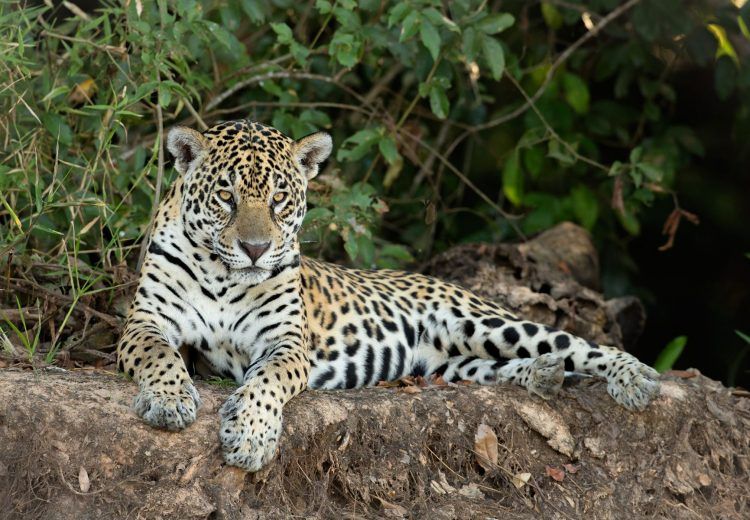
South America (including Galapagos)
August 2025
BRAZIL’S PANTANAL: JAGUARS AND SO MUCH MORE – South America’s best wildlife photography destination
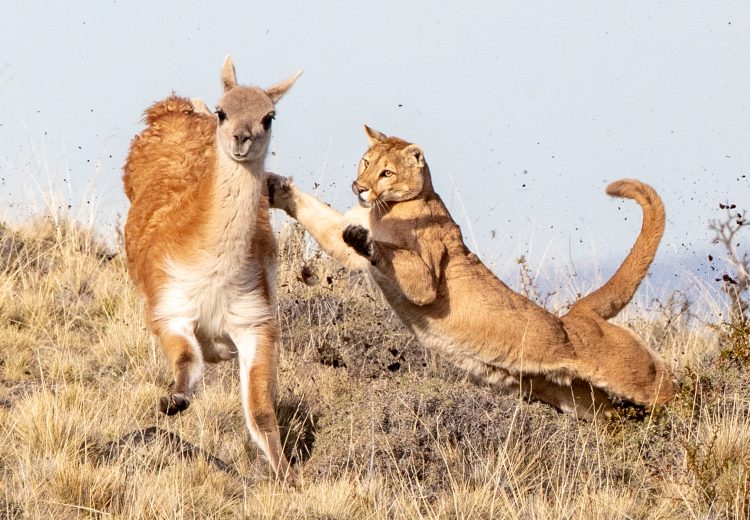
South America (including Galapagos)
September 2025
CHILE: WALKING WITH PUMAS – An Extraordinary Photographic Adventure at Torres del Paine
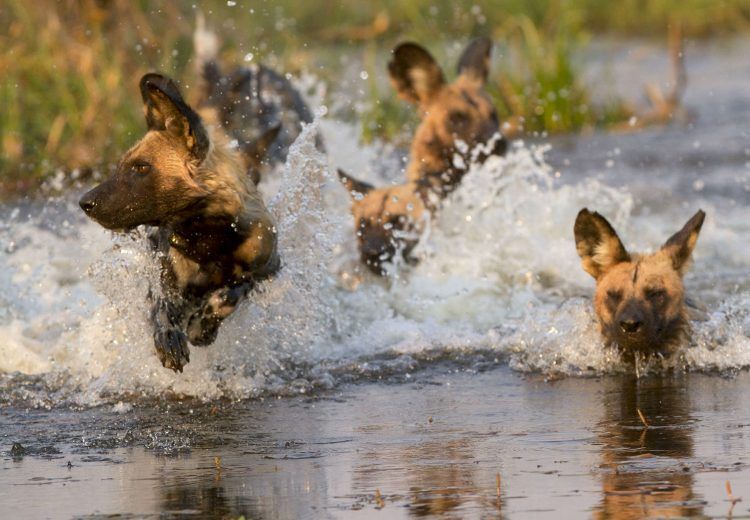
Botswana & The Okavango
November 2025

































